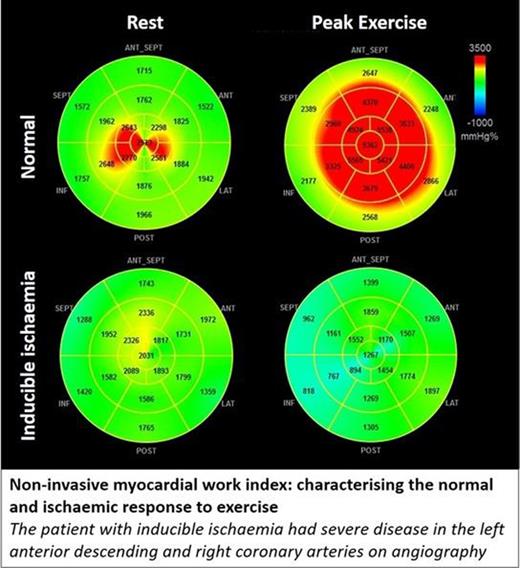-
PDF
- Split View
-
Views
-
Cite
Cite
A Borrie, C Goggin, S Ershad, W Robinson, A Sasse, Non-invasive myocardial work: characterising the normal and ischaemic response to exercise, European Heart Journal, Volume 41, Issue Supplement_2, November 2020, ehaa946.0110, https://doi.org/10.1093/ehjci/ehaa946.0110
Close - Share Icon Share
Abstract
Myocardial work and work efficiency are new parameters for assessing left ventricular function. They have been shown to have value in a range of clinical settings but have not previously been applied to exercise stress echocardiography.
We aim to characterize the normal myocardial work and work efficiency response to exercise in a mixed population and determine if myocardial work could be used to identify patients with inducible ischaemia.
Patients were retrospectively enrolled from an existing database of exercise stress echocardiography. Inclusion criteria were a clinical indication of possible ischemia and technical suitability to calculate myocardial work. Exclusion criteria were abnormal baseline left ventricular function or inadequate image quality. Echocardiograms positive for ischaemia were defined by independent visual assessment and compared with angiographic findings where available. Myocardial work and work efficiency were calculated using a proprietary algorithm.
A total of 177 patients met inclusion criteria, 117 were excluded leaving 40 normal and 20 positive tests for analysis. During normal exercise global work increased 54% and efficiency remained at 96%. Segmental work showed a basal to apical gradient which became more prominent at peak exercise. In patients with inducible ischaemia during exercise there was a significant difference in response; work decreased by 1.9% and efficiency dropped to 87%. Receiver operating characteristic curve for myocardial work had an area under the curve of 0.94. Youden's J statistic suggested an optimum cut point of a 25% increase in work to define a normal test.
During normal exercise myocardial work increased and efficiency remained unchanged, however during exercise induced ischaemia both myocardial work and efficiency decreased. We have demonstrated that myocardial work can be applied to stress echocardiography to identify ischemia but the utility of this remains uncertain. Further research compared to an objective measure of functional ischemia is needed.
Global myocardial work during exercise
| . | Normal (n=40) . | Inducible ichaemia (n=20) . | p . |
|---|---|---|---|
| Rest (mmHg%) | 2296±315 | 2069±379 | 0.02 |
| Peak (mmHg%) | 3523±651 | 2070±639 | <0.001 |
| Change (%) | +54±25 | −1.9±29 | <0.001 |
| . | Normal (n=40) . | Inducible ichaemia (n=20) . | p . |
|---|---|---|---|
| Rest (mmHg%) | 2296±315 | 2069±379 | 0.02 |
| Peak (mmHg%) | 3523±651 | 2070±639 | <0.001 |
| Change (%) | +54±25 | −1.9±29 | <0.001 |

Response to exercise
Type of funding source: None



